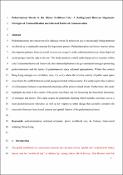Options
Pedestrianised streets in the global neoliberal city: A battleground between hegemonic strategies of commodification and informal tactics of commoning
Author(s)
Date Issued
2021-01
Date Available
2024-02-26T15:35:14Z
Abstract
Pedestrianisation, the conversion of a vehicular street for pedestrian use, is increasingly being proposed worldwide as a sustainable measure by hegemonic powers. Pedestrianisation can bolster uneven urban development patterns, however social tensions can magnify on the pedestrianised street, where deprived social groups claim the right to the city. This study employs a mixed method approach to examine, within a de Certeausian theoretical framework, the relationship between the governmental strategies promoting pedestrianisation and the tactics of pedestrianised space informal appropriation. Within this context Hong Kong emerges as a revelatory case, it is a city where the extreme scarcity of public open space exacerbates the conflict between social groups interested in this resource. The analysis provides evidence of a discrepancy between expected and actual uses of the pedestrianised streets. Furthermore, this study highlights the need in the context of the global neoliberal city for discussing the theoretical dichotomy of strategies and tactics. This paper argues for pedestrian planning which includes stationary use as a main pedestrianisation objective, as well as for responsive urban design that carefully considers the association between behavioural patterns and spatial features of the pedestrianised street.
Other Sponsorship
City University of Hong Kong
Type of Material
Journal Article
Publisher
Elsevier
Journal
Cities
Volume
108
Start Page
1
End Page
16
Copyright (Published Version)
2020 Elsevier
Language
English
Status of Item
Peer reviewed
ISSN
0264-2751
This item is made available under a Creative Commons License
File(s)
Loading...
Name
Manuscript_cities.pdf
Size
2.76 MB
Format
Adobe PDF
Checksum (MD5)
fb0c5713eb2e8438e967cd337e495552
Owning collection